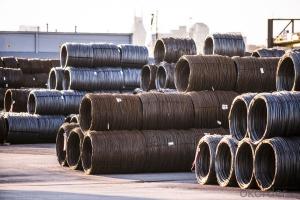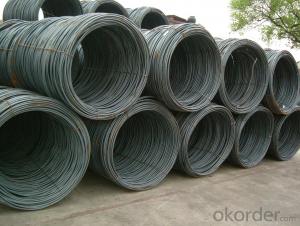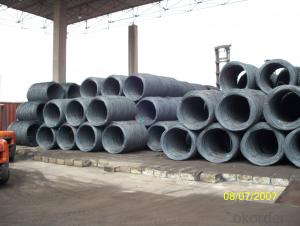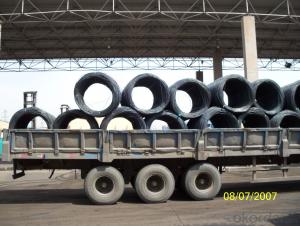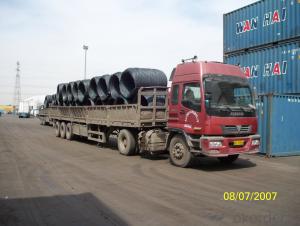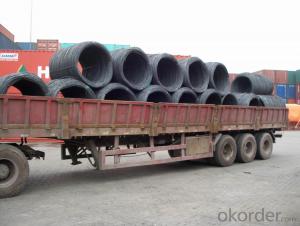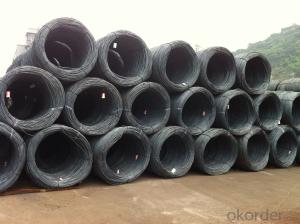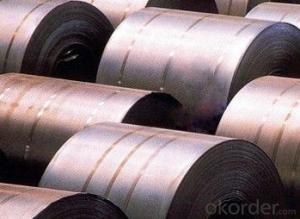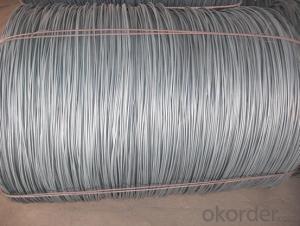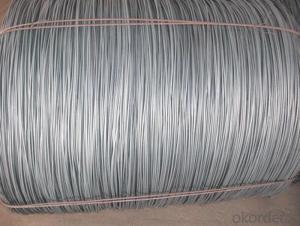SAE1006Cr Carbon Steel Wire Rod 6.5mm for Welding
- Loading Port:
- Shanghai
- Payment Terms:
- TT OR LC
- Min Order Qty:
- 100 m.t
- Supply Capability:
- 30000 m.t/month
OKorder Service Pledge
OKorder Financial Service
You Might Also Like
Item specifice
Description of SAE1006Cr Carbon Steel Wire Rod 6.5mm for Welding:
OKorder is offering Color Coated Steel Coil Prepainted Steel Coil at great prices with worldwide shipping. Our supplier is a world-class manufacturer of steel, with our products utilized the world over. OKorder annually supplies products to European, North American and Asian markets. We provide quotations within 24 hours of receiving an inquiry and guarantee competitive prices.
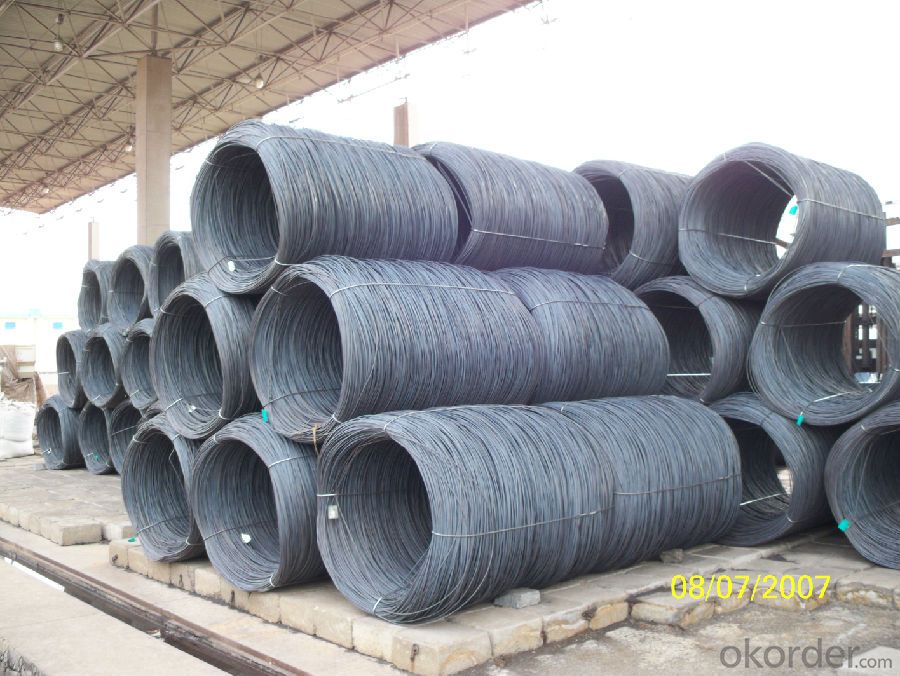
Applications of SAE1006Cr Carbon Steel Wire Rod 6.5mm for Welding:
Color Coated Steel Coil Prepainted Steel Coil are ideal for structural applications and are widely used in the construction of buildings and bridges, and the manufacturing, petrochemical, and transportation industries.
Main Product Features of SAE1006Cr Carbon Steel Wire Rod 6.5mm for Welding:
· Premium quality
· Prompt delivery & seaworthy packing (30 days after receiving deposit)
· Corrosion resistance
· Can be recycled and reused
· Mill test certification
· Professional Service
· Competitive pricing
Specifications of SAE1006Cr Carbon Steel Wire Rod 6.5mm for Welding:
PPGI:
1, Introduction: Color coated steel coils(sheets), i. E. PPGI, also called prepainted steel coils(sheets), are made of galvanized steel coils(sheets) with polymer coatings as surface. It's a new enclosure material and building board with characteristics of light-weighted, heat preserved&insulated, easily installed with bright colors.
2, Production Process: Pretreatment(Degreasing)_Drying_Chromating_Paint Basic Oil_Cooling_Drying_Color Coating_Cooling_Film-covering_Rolling Up
3, Characteristics:
Good at corrosion resistence. Besides zinc coating of the basic plate of galvanized steel sheet, the color coating as the surface has double lifetime to ensure better anticorrosion effect.
With excellent cold bending molded manufacturablity, PPGI products can be processed or directly used as final product. As being light-weighted and conveniently transported, they're widly used to replace wood to save energy.
There're thousands of colors can be chosen as per different application. Any color plays well in decoration.
No pollution with high recycling rate, PPGI coils and sheets are strongly recommended as enviroment-friendly products by the government.
5, eye bands and 4 circumferential bands in steel, galvanized metal fluted rings on inner and outer edges, galvanized.
| commodity | SAE1006Cr Carbon Steel Wire Rod 6.5mm for Welding |
| Techinical Standard: | JIS G3302-1998, EN10142/10137, ASTM A755 |
| grade | Q195,Q215,Q235,SAE1006,SAE1008 SAE1006Cr |
| Types: | Mesh welding |
| Base metal | galvanized, galvalume, cold rolled steel |
| Thickness | 0.14-1.0mm(0.16-0.8mm is the most advantage thickness) |
| Width | 610/724/820/914/1000/1200/1219/1220/1250mm |
| Type of coating: | PE, SMP, PVDF |
| Zinc coating | Z60-150g/m2 or AZ40-100g/m2 |
| Top painting: | 5 mic. Primer + 15 mc. R. M. P. |
| Back painting: | 5-7 mic. EP |
| Color: | According to RAL standard |
| ID coil | 508mm610mm |
| Coil weight: | 2--3MT |
| Package: | Properly packed for ocean freight exportation in 20'containers |
| Application: | Industrial panels, roofing and siding for painting/automobile |
| Price terms | FOB, CFR, CIF |
| Payment terms | 20%TT in advance+80% TT or irrevocable 80%L/C at sight |
| delivery time | 25 days after recepit of 20% TT |
| Remarks | Insurance is all risks |
| MTC 3.1 will be handed on with shipping documents | |
| We accept SGS certificatation test |
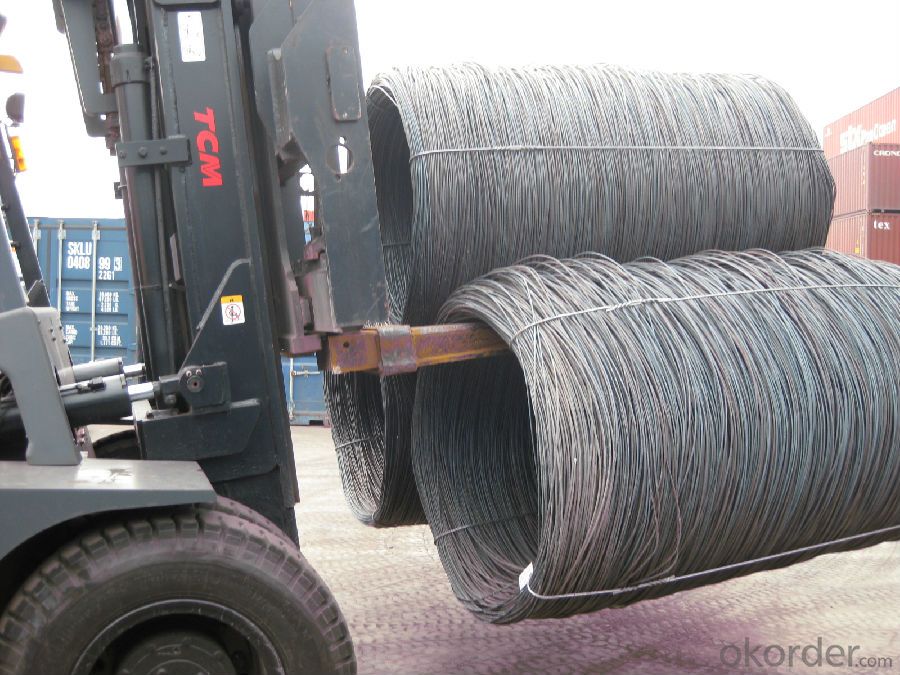
FAQ of SAE1006Cr Carbon Steel Wire Rod 6.5mm for Welding:
Q1: Why buy Materials & Equipment from OKorder.com?
A1: All products offered byOKorder.com are carefully selected from China's most reliable manufacturing enterprises. Through its ISO certifications, OKorder.com adheres to the highest standards and a commitment to supply chain safety and customer satisfaction.
Q2: How do we guarantee the quality of our products?
A2: We have established an advanced quality management system which conducts strict quality tests at every step, from raw materials to the final product. At the same time, we provide extensive follow-up service assurances as required.
Q3: How soon can we receive the product after purchase?
A3: Within three days of placing an order, we will begin production. The specific shipping date is dependent upon international and government factors, but is typically 7 to 10 workdays.
Q4: What makes stainless steel stainless?
A4: Stainless steel must contain at least 10.5 % chromium. It is this element that reacts with the oxygen in the air to form a complex chrome-oxide surface layer that is invisible but strong enough to prevent further oxygen from "staining" (rusting) the surface. Higher levels of chromium and the addition of other alloying elements such as nickel and molybdenum enhance this surface layer and improve the corrosion resistance of the stainless material.
Q5: Can stainless steel rust?
A5: Stainless does not "rust" as you think of regular steel rusting with a red oxide on the surface that flakes off. If you see red rust it is probably due to some iron particles that have contaminated the surface of the stainless steel and it is these iron particles that are rusting. Look at the source of the rusting and see if you can remove it from the surface.
- Q:What are the common applications of low alloy and oil tempered steel wire rod?
- Some common applications of low alloy and oil tempered steel wire rod include automotive components, construction materials, wire ropes, springs, and cables. These types of steel wire rod offer enhanced strength, durability, and resistance to corrosion, making them suitable for various industries where high-performance materials are required.
- Q:What are the common welding techniques for steel wire rod?
- There are several common welding techniques used for steel wire rods, depending on the specific application and desired outcome. Some of the most commonly used techniques include: 1. Gas Metal Arc Welding (GMAW): Also known as MIG (Metal Inert Gas) welding, this technique uses a consumable wire electrode and a shielding gas to create a weld. GMAW is commonly used for welding steel wire rods due to its versatility, ease of use, and ability to produce high-quality welds. 2. Gas Tungsten Arc Welding (GTAW): Also known as TIG (Tungsten Inert Gas) welding, this technique uses a non-consumable tungsten electrode and a shielding gas to create a weld. GTAW is often used for precision welding applications where a high level of control and a clean, aesthetically pleasing weld are required. 3. Flux-Cored Arc Welding (FCAW): This technique uses a tubular wire electrode with a flux-filled core. The flux provides a shielding gas and helps remove impurities from the weld zone. FCAW is commonly used for welding steel wire rods in outdoor or windy environments where the shielding gas from GMAW or GTAW may be compromised. 4. Shielded Metal Arc Welding (SMAW): Also known as stick welding, this technique uses a consumable electrode coated in flux. The flux creates a shielding gas and helps remove impurities from the weld zone. SMAW is a versatile and portable welding technique commonly used for steel wire rods in various applications. 5. Resistance Welding: This technique involves passing an electric current through the steel wire rods to create resistance and generate heat, which fuses the materials together. Resistance welding is commonly used for high-speed production welding of steel wire rods, such as in the manufacturing of wire mesh or fences. It is important to select the appropriate welding technique based on factors such as the type of steel wire rod, the desired strength and quality of the weld, the welding environment, and the available equipment and resources.
- Q:What are the different formability testing methods for steel wire rod?
- Steel wire rod can be evaluated for its behavior using various formability testing methods. These methods aim to determine the wire rod's ability to deform and bend without cracking or breaking. Some commonly used formability testing methods for steel wire rod include the following: 1. Cupping test: A blank of the steel wire rod is placed in a shallow die, and a controlled force is applied to deform the material. The depth of the formed cup before cracking or fracturing occurs is measured to assess the formability of the wire rod. 2. Erichsen test: This test involves using a hemispherical punch to deform the steel wire rod until a crack or fracture appears. The maximum punch depth before failure is measured and serves as an indicator of the wire rod's formability. 3. Tensile test: Widely utilized, this test evaluates the mechanical properties of materials, including the formability of steel wire rod. The wire rod is subjected to tension until it fractures, and parameters such as elongation, reduction in area, and ultimate tensile strength are measured and analyzed. 4. Bend test: The wire rod is bent to a specified angle, and the surface is examined for cracks or fractures. The angle at which the wire rod fails to maintain its original shape indicates its formability. 5. Flattening test: This test involves flattening the wire rod between two parallel plates until it fractures. The maximum load or pressure required for failure is measured and used as an indicator of formability. 6. Hole expansion test: This test evaluates the wire rod's ability to expand without cracking when subjected to a punching force. The maximum hole diameter that can be achieved without failure is measured, indicating the wire rod's formability. These formability testing methods assist manufacturers and researchers in determining the suitability of steel wire rod for various applications, such as automotive components, construction materials, and manufacturing processes. By understanding the wire rod's formability characteristics, engineers can make informed decisions regarding material selection and process optimization.
- Q:What are the different types of steel wire rod surface defect prevention techniques?
- Some of the different types of steel wire rod surface defect prevention techniques include surface cleaning and descaling, mechanical removal of defects, surface coating or plating, and proper handling and storage practices.
- Q:How is steel wire rod used in the production of wire for wire rope slings?
- The production of wire rope slings relies heavily on steel wire rod. This raw material is used to manufacture the wire ropes that are essential components of wire rope slings. To transform the wire rod into wire ropes, a series of manufacturing steps are undertaken. These steps include drawing, stranding, and closing the wire ropes. Initially, the wire rod is drawn through a die to decrease its diameter and increase its length. This process enhances the wire's strength and flexibility. Once the drawing process is complete, the wire rod is then stranded by twisting multiple wires together to form a strand. Multiple strands are further twisted to create the wire rope. This stranding process adds strength and durability to the wire rope, making it suitable for demanding applications. To complete the manufacturing process, the wire rope is closed by utilizing specialized machinery to form a loop or an eye on one or both ends. This closure ensures a secure attachment of the wire rope to equipment or structures, allowing for safe lifting and handling. In summary, steel wire rod plays a crucial role in the production of wire for wire rope slings. Through various manufacturing processes, the wire rod is transformed into wire ropes that possess exceptional strength, flexibility, and durability. These wire ropes are then utilized in the construction of wire rope slings, which are extensively used in lifting and rigging operations across diverse industries.
- Q:How is steel wire rod used in the manufacturing of wire for shipbuilding applications?
- The manufacturing of wire for shipbuilding heavily relies on steel wire rod due to its superior strength and durability. To begin the process, high-quality steel wire rod is carefully selected as the raw material. Thorough inspection and testing are conducted on the steel wire rod to ensure it meets industry standards for strength, corrosion resistance, and other essential properties. Once it passes these tests, the wire rod proceeds to the wire drawing process. During the wire drawing process, the steel wire rod is repeatedly pulled through dies to decrease its diameter and increase its length. This procedure is repeated until the desired diameter and length of the wire are achieved. Additionally, the wire drawing process enhances the wire's strength and surface quality, making it ideal for shipbuilding applications that require high tensile strength and corrosion resistance. Following the wire drawing process, the wire often undergoes additional treatments, such as annealing or heat treatment, to further enhance its mechanical properties. These treatments improve the wire's strength, ductility, and resistance to fatigue, ensuring it can withstand the demanding conditions encountered in shipbuilding. Once the wire has been processed and treated, it is wound onto large reels or coils for easy handling during the shipbuilding process. The wire is then utilized in various shipbuilding applications, including structural supports, cables, rigging, and other critical components that demand exceptional strength and durability. In summary, steel wire rod is of utmost importance in the manufacturing of wire for shipbuilding. Its ability to provide the necessary strength, durability, and corrosion resistance required in marine environments makes it an indispensable material in constructing ships capable of withstanding the challenges of the sea.
- Q:How is the chemical composition of steel wire rod analyzed?
- Various techniques and methods are typically used to analyze the chemical composition of steel wire rod. One commonly employed method is spectroscopy, which utilizes instruments like atomic absorption spectroscopy (AAS) or inductively coupled plasma spectroscopy (ICP) to accurately determine the presence and concentration of different elements in the steel wire rod. Another frequently used technique is X-ray fluorescence (XRF), which involves bombarding the sample with X-rays and measuring the energy emitted by the elements present in the steel wire rod. This method provides a fast and non-destructive analysis of the chemical composition. In addition to spectroscopy and XRF, other methods such as optical emission spectroscopy (OES) and mass spectrometry can also be utilized for analyzing the chemical composition of steel wire rod. These techniques involve vaporizing and ionizing the sample, followed by measuring the resulting ions or emitted photons. It is important to note that these techniques necessitate the preparation of the steel wire rod as a sample, often in the form of a solid or liquid. The sample is typically dissolved, digested, or mixed with appropriate reagents to extract the elements of interest before analysis. Overall, analyzing the chemical composition of steel wire rod is a critical step in quality control and ensuring that the material meets the required specifications for its intended use.
- Q:What are the different types of steel wire rod annealing atmospheres?
- Depending on the desired outcome and specific requirements of the process, there are various types of annealing atmospheres for steel wire rods. These atmospheres differ in terms of the gases used and the conditions maintained during annealing. 1. Nitrogen Atmosphere: Steel wire rod annealing processes commonly utilize nitrogen gas. This inert gas protects the material from oxidation and decarburization. It creates a stable environment for consistent and controlled heat treatment. 2. Hydrogen Atmosphere: Another frequently used annealing atmosphere for steel wire rods is hydrogen gas. Hydrogen helps minimize surface oxidation and can remove surface contaminants or impurities, resulting in a clean and bright surface finish. 3. Vacuum Atmosphere: Vacuum annealing involves creating a low-pressure environment by removing air and other gases from the annealing chamber. This atmosphere prevents oxidation and provides precise control over the annealing process. Vacuum annealing is ideal for high-quality wire rods with minimal surface defects and improved mechanical properties. 4. Inert Gas Mixtures: In certain cases, a combination of inert gases like nitrogen and hydrogen may be used as an annealing atmosphere. This mixture offers the advantages of both gases, including protection against oxidation and impurity removal. The specific mixture and ratios depend on the desired outcome and material requirements. 5. Controlled Atmosphere Furnaces: Controlled atmosphere furnaces enable precise regulation of the annealing atmosphere by continuously monitoring and adjusting the gas composition. This allows for the optimization of annealing conditions to achieve desired material properties and surface finishes. It is important to consider the specific steel composition, desired properties, and end-use application of the wire rod when selecting the annealing atmosphere. By carefully choosing the appropriate atmosphere, steel wire rods can undergo a controlled heat treatment process that enhances their mechanical properties, surface quality, and overall performance.
- Q:How does the dimensional accuracy of steel wire rod vary with different heat treatment processes?
- Different heat treatment processes can result in varying dimensional accuracy for steel wire rods. Heat treatment involves subjecting the wire rod to controlled heating and cooling procedures that alter its physical and mechanical properties. One commonly used heat treatment process for steel wire rods is annealing. Annealing involves heating the wire rod to a specific temperature and then gradually cooling it. This process helps alleviate internal stresses, enhance ductility, and refine the grain structure of the steel. In terms of dimensional accuracy, annealing can minimize internal stresses that may lead to distortion or warping in the wire rod, resulting in improved dimensional stability. Another heat treatment process is quenching and tempering. Quenching involves rapidly cooling the wire rod after heating it to a high temperature, typically using a liquid like oil or water. This rapid cooling hardens the steel, making it stronger but also more brittle. To enhance toughness and reduce brittleness, the wire rod is then tempered by reheating it to a lower temperature and slowly cooling it. The quenching process can affect dimensional accuracy due to the rapid cooling, which may cause distortion or warping. However, tempering helps decrease brittleness and minimize distortion, leading to improved dimensional accuracy. Additionally, other heat treatment processes such as normalizing and stress relieving can also impact the dimensional accuracy of steel wire rods. Normalizing involves heating the wire rod to a specific temperature and allowing it to cool in still air. This process refines the grain structure and improves the mechanical properties of the steel. On the other hand, stress relieving involves heating the wire rod to a temperature below the critical range and gradually cooling it, which reduces internal stresses. Both normalizing and stress relieving can contribute to improved dimensional accuracy by minimizing distortions or warping. To summarize, the dimensional accuracy of steel wire rods can vary depending on the heat treatment process used. Annealing, quenching and tempering, normalizing, and stress relieving are some commonly employed heat treatment processes that can affect dimensional accuracy. Careful consideration should be given to the choice of heat treatment process in order to achieve the desired dimensional accuracy while also meeting the required mechanical properties of the steel wire rod.
- Q:How is steel wire rod used in automotive applications?
- Steel wire rod is used in various automotive applications due to its strength, durability, and versatility. It is commonly utilized in the production of springs, cables, belts, and reinforcements for tires. Additionally, steel wire rod is crucial in the manufacturing of safety components such as seat belts and airbags, ensuring the overall safety and reliability of vehicles on the road.
1. Manufacturer Overview |
|
|---|---|
| Location | |
| Year Established | |
| Annual Output Value | |
| Main Markets | |
| Company Certifications | |
2. Manufacturer Certificates |
|
|---|---|
| a) Certification Name | |
| Range | |
| Reference | |
| Validity Period | |
3. Manufacturer Capability |
|
|---|---|
| a)Trade Capacity | |
| Nearest Port | |
| Export Percentage | |
| No.of Employees in Trade Department | |
| Language Spoken: | |
| b)Factory Information | |
| Factory Size: | |
| No. of Production Lines | |
| Contract Manufacturing | |
| Product Price Range | |
Send your message to us
SAE1006Cr Carbon Steel Wire Rod 6.5mm for Welding
- Loading Port:
- Shanghai
- Payment Terms:
- TT OR LC
- Min Order Qty:
- 100 m.t
- Supply Capability:
- 30000 m.t/month
OKorder Service Pledge
OKorder Financial Service
Similar products
New products
Hot products
Hot Searches
Related keywords
